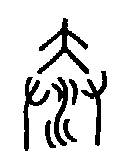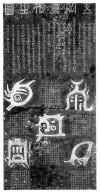
C.A.S. Williams 'Chinese symbolism and
art motifs', p.376
Mount T'ai, in Shantung, has the epithet
of "eminent” attached to it as it is the most famous of all the mountains
of China. A stone from this sacred mountain is believed to have the power to
ward off demons, though any local stone may be employed. The following
inscription is cut upon it: “This stone from Mount T‘ai dares to oppose”,
and it is sometimes erected at sharp turnings of the road where evil influences
are considered likely to strike against it. No doubt the origin of the motto is
partly due to the security offered by Mount T‘ai in times of flood and Yellow
River disaster in Shantung, and to its former use in the worship of the sun.
Authority

This rubbing was taken from a stone stele kept at the Zhong-yue Miao, or Temple of the Central Peak, on Mount Song in Henan province. The temple has a number of stelae illustrating this theme, of which this is the oldest. It shows the "true forms” of the Five Sacred Peaks (wuyue) of China. They are as follows: the Eastern Peak of Mount Tai (Shandong province), shown in the upper right, the Southern Peak of Mount Heng (Hunan province), shown in the lower right, the Western Peak of Mount Hua (Shaanxi province), shown in the lower left, the Northern Peak of Mount Heng (Hebei province), shown in the upper left, and the Central Peak of Mount Song (Henan province), shown in the middle. Each “true form" is accompanied by an inscription that tells where the peak is located, which of the Five Planets it corresponds to in the Five Phase system (see cat. no. 17), and what god rules over it. Additional information, such as the most famous classical reference to the peak, the titles given to its god in the Kaiyuan era (713 – 41) of the Tang dynasty, and the changes made to the titles in the Song dynasty (960 – 1279), is also included.
Above the talismans there is an inscription dated to 1604, during the Wanli reign (1573 – 1620) of the Ming dynasty, by the government official Fang Damei,* who served as a Regional Inspector of Henan for the Censorate when this was written. Fang states that the "true forms" of the Five Sacred Peaks were first given to Emperor Wudi of the Han dynasty (r. 140 – 87 BC) by the Queen Mother of the West (Xiwangmu). This statement is based on a medieval legend of Emperor Wudi, wherein he was given sacred scriptures by the Queen Mother of the West and the Lady of the Highest Primordial (see cat. nos. 26, 97). He mounted these scriptures on violet brocade with a coral roller, placed them in a gold case and sealed them in a box of white jade. However, Wudi's nature was too violent and lustful to be suited to the Way, and after becoming disappointed with his progress, the Queen Mother caused all the scriptures, and the building in which they were kept, to be burned.
Fortunately, the emperor transmitted a copy
of the "true forms" of the Five Peaks to his minister Dong Zhongshu,
and all later copies derived from this one. While this story resides in the
realm of legend rather than historical fact, the "true forms" existed
in some shape by the Jin dynasty (265-420), and are mentioned prominently by Ge
Hong, who says, "I have heard Master Zheng [Ge's teacher] say that there
are no more significant works on the Way than the Writ of the Three August and
the illustration of the True Forms of the Five Peaks."'
The "true forms" of the Five Peaks seen here were common in both China and Japan, and can also be found on later stelae such as one dated to 1682 in Xi’an, of which the Field Museum in Chicago has a rubbing.’ At the same time, the Ming dynasty Taoist Canon, which was printed over a century before the present stele, preserves an alternate version of the "true forms" of the Five Peaks; the former are more abstract and talismanic, while the latter resemble maps that highlight areas of sacred significance within each peak.
There is a. great deal of information regarding the cults of mountains in the Han dynasty (206 B.C.– A.D. 220). Since this period, a standard group of Five Sacred Peaks has been worshipped as gods in China. The origins of the veneration of individual sacred mountains (yue) can be traced back to the late Shang dynasty (thirteenth – eleventh century B.C.); such peaks are mentioned in the oracle bone inscriptions excavated at the last Shang capital, Anyang. Mountains were seen as powerful forces in the Han and Six Dynasties periods. In Ge Hong's The Master who embraces Simplicity (Baopuzi) of the fourth century, there are famous passages that discuss ways of moving through mountains, and the herbs and minerals found on sacred peaks that aid self-cultivation and alchemy:
All mountains, whether large or small, have gods and spirits (shenling). If the mountain is large, the god is great; if the mountain is small, the god is minor, If someone enters the mountain possessed of no magical arts, he will certainly suffer harm. Some will fall victim to acute diseases or be wounded by weapons. When frightened and uneasy, some will see lights and shadows, others will hear strange sounds. Sometimes a huge tree will topple, though there is no wind, or a cliff will collapse for no reason, striking and killing people. Sometimes the man will flee in confusion, tumbling down a cavern or into a gorge; other times he will encounter tigers, wolves and poisonous insects that attack men. One cannot enter a mountain lightly!
Ge
Hong's Baopuzi is also the first text to mention the sacred talismans or
"true Forms" (zhenxing) of the Five Sacred Peaks (see cat. no.
137). With the greater institutionalization of Taoism in the Tang dynasty, the
gods of the Five Sacred Peaks came increasingly under the control of higher
Taoist gods. In the early eighth century, the guidelines for imperial worship of
these mountains were determined by the Taoist church. Mount Tai (Tai Shan), in
the east, has been perceived as the most important of the Five Sacred Peaks
since the third century B.C., and by the end of the Song dynasty (960-1279)
there was a temple to the god of Tai Shan in almost every major city in China.
The close connections between Taoism and mountains cults are illustrated by the
fact that in 1349 a temple to the Emperor of the Eastern Peak (Dongyue dadi) was
built at the Yongle Gong in Ruicheng, Shanxi province, the birthplace of the
immortal Lü Dongbin (see cat. nos. 120-22) .
